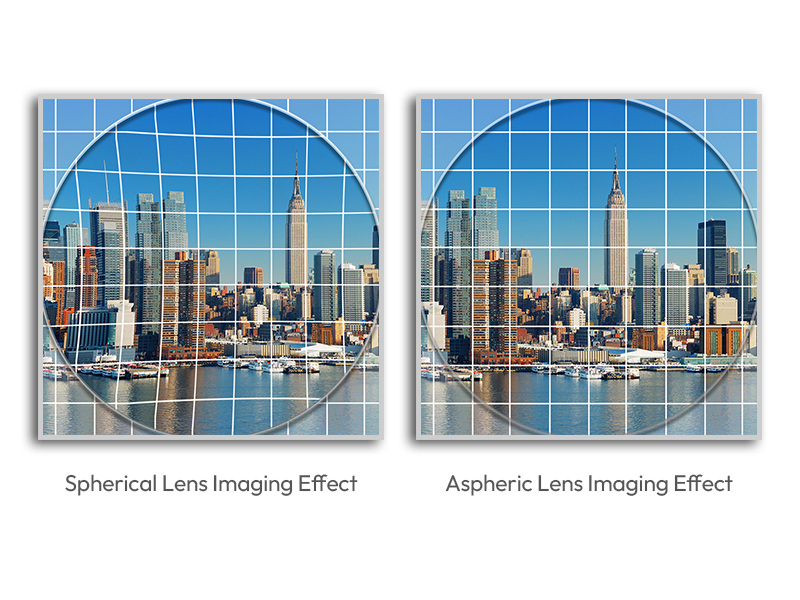- Eyeglasses
- Glasses
- Shop By Frame
- Shop By Style
- Featured
- Premium Selection
- Sunglasses
- Kids' Glasses
- Readers
- Shop By Lens
- Promium Selection
- Accessories
- My Orders
- Order Tracking
- Blog
- Have a Question?
- E-mail:cs@efeglasses.com


When you're choosing a new pair of glasses for yourself, whether online or in a physical store, many people face the choice between spherical and aspherical lenses.
What are spherical lenses? What are aspherical lenses? And what are the differences between them? Of course, the most obvious difference is in the price. So why are aspherical lenses generally more expensive than spherical lenses, and why are aspherical lenses usually recommended when you're getting new glasses? Don't worry, today we'll unravel this mystery together.
Let's start by looking at what spherical lenses are.
The lenses used in most optical devices can be considered as parts of a sphere. Their surface curvature is fixed. When light rays emitted from the same object point on the optical axis pass through the lens, they converge at different points in the image field space, resulting in a shift in the image formation position. This is what we commonly call spherical aberration.
Because spherical lenses have this issue, their shortcomings become apparent.
The peripheral areas of spherical lenses have a higher power than the average power, so there will be differences between central and peripheral vision. Peripheral vision may appear distorted and blurry. This problem is not obvious at low prescriptions, but at higher prescriptions, the thickness of the lenses also increases, putting pressure on the bridge of the nose, and reducing wearing comfort.
To address these shortcomings of spherical lenses, aspherical lenses were developed.
Simply put, aspherical lenses are lenses whose refractive surfaces are not spherical. Their design is more advanced than spherical lenses, effectively correcting aberrations and distortions, and resolving issues such as blurred vision, distorted vision, and a narrow field of view. In addition, the structural design of aspherical lenses is thinner and flatter, making them more comfortable to wear, especially for those with high myopia, and significantly reducing the burden on the bridge of the nose.
So, where exactly do the advantages of aspherical lenses lie?
From an optical perspective, aspherical lenses can effectively reduce lens aberrations, making the field of view clearer. The optical design of spherical lenses is more limited, making it difficult to completely eliminate aberrations caused by high prescriptions. In contrast, the design of aspherical lenses is more precise, resulting in higher manufacturing costs, which explains why aspherical lenses are generally more expensive than spherical lenses. Furthermore, aspherical lenses are thinner at the edges, making them not only more aesthetically pleasing and comfortable to wear, but also particularly suitable for people who drive or engage in activities at night.
After reading this, you might ask: How can I quickly distinguish between spherical and aspherical lenses in everyday life?
It's simple. Under the same material and prescription conditions, aspherical lenses are usually thinner, flatter, and provide a more natural and realistic visual effect. Simply hold the lenses up to a light source and observe the reflected lines: the light lines reflected from aspherical lenses are generally straight and flat, while the lines from spherical lenses are noticeably curved.
With the explanation above, you should now have a clear understanding of the differences between spherical and aspherical lenses, and be able to make the most suitable choice for yourself.
SUBSCRIBE & SAVE
- Shop All
- Best Sellers
- Eyeglasses
- Sunglasses
- Reading Glasses
- Shop By Frame
- Shop By Style
- Glasses Colors
- Black Glasses
- Blue Glasses
- Brown Glasses
- Gold Glasses
- Green Glasses
- Orange Glasses
- Pink Glasses
- Red Glasses
- Yellow Glasses
- Silver Glasses
- White Glasses
- Purple Glasses
- Tortoiseshell Glasses
- Clear Glasses
- Transparent Grey Glasses
- Mens Blue Glasses Frames
- Red Sunglasses
- Rose Gold Glasses
- White Frame Sunglasses
- Black And Clear Eyeglass Frames
- Black And Gold Glasses
- Black And Red Glasses
- Black Glasses For Women
- Black Rectangle Glasses
- Black Rectangle Sunglasses
- Blue Light & Blocking Glasses
- Blue Women Eyeglasses
- Tips & Guides
- About EFE
- Shop



















